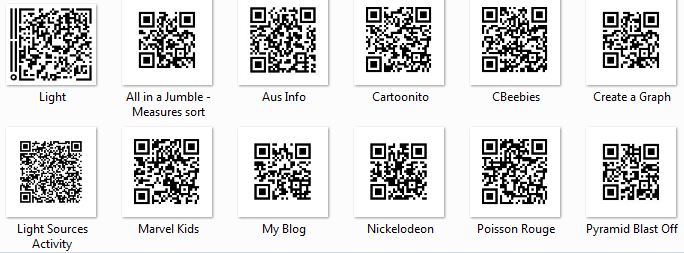In the last week I have finally had the opportunity to use Quick Response (QR) codes in my classroom. I have found them simple, straightforward and very effective in improving access to digital resources.
I have been thinking about ideas to use QR codes in the classroom for a long while and many colleagues have joined me in contributing to a shared “Interesting Ways” resource. It outlines many useful and innovative ways to utilise the QR codes in the classroom and around school.
I have noticed that some people consider them to be exclusive to mobile devices. (The printed code needs to be read by some software that then displays a link, information or similar.) It seems many people think that only mobile devices like the new iPod or smartphones could do it. However we have been using them with desktop software on our class netbooks and the in-built webcam.
Another assumption I have spotted is that we use QR codes that are displayed (static) and we take the device to the code. I have seen it in a different way, producing printed codes which the children use on their own netbook to access websites and other digital resources. Taking the code to the reader.
We use the desktop version of the QuickMark software that is a free dowload. The children load up the software, hold the printed code in front of the camera and away they go. The URL is displayed, a double-click and they are on the site.
Now I did a mini experiment and monitored how many children had trouble loading a website that I gave them as a shortened (bit.ly) url – so not even the full address. We had 4 pairs of children who needed help to enter the url correctly. Using QR codes I have had none.
I know that QR codes can be, have been and will be used for far more innovative and creative ideas – but I know that my class can all get to a website faster and with less intervention using the codes. That is technology increasing independence and solving a real classroom problem.
Image may be NSFW.
Clik here to view.
I print lots of the same codes out and just let the children hold up a whole A4 sheet of them or little row of three of the same code backed onto card. The software reads a bigger area and it seems to increase the likelihood it reads the code – after all you don’t want to have to go and help them use the codes, that would defeat the purpose.
As an extension to a maths activity this week I had a website lined up for some children who had finished their planned activities. In the past I might have made a link on our blog or used Delicious, or perhaps displayed the address or had to show them myself. Instead I had a zip wallet of codes and the children just scanned them and they were away – in fact it seemed to me to not only improve access but speed it up. (Google Chrome helps too)
I am keen to talk to the early years staff to begin to integrate the codes into their environments, such as having a little roll-a-dex of QR codes for Nursery children to choose from – on the back of the codes perhaps a picture or symbol of the website they want to use. I know it would help them to independently choose and structure their own web use and ultimately rely less on staff intervention.
We must not forget about the most simple ways to use these incredible technical developments – put simply: using QR codes improves the ability of my class to quickly and independently access websites.
